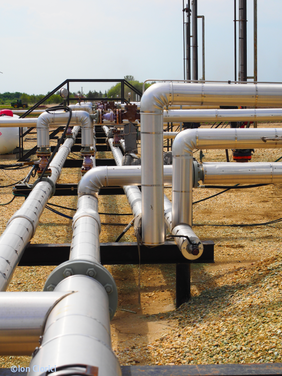Halliburton is an American multinational corporation, one of the world´s largest oil field service companies. It operates in more than 70 countries and employs approximately 50,000 people.
Halliburton provides services and products to the upstream oil and natural gas industry during the life cycle of the reservoir, starting from locating hydrocarbons and managing geological data, to drilling and formation evaluation, well construction and completion, and optimizing production.
The Company has two operating segments which are the Completion and Production segment and the Drilling and Evaluation segment.
Completion and Production delivers cementing, stimulation, intervention, pressure control, specialty chemicals, artificial lift and completion services.
Drilling and Evaluation provides field and reservoir modelling, drilling, evaluation and precise wellbore placement solutions that enable customers to model, measure, drill and optimize their well construction activities. The segment consists of Baroid drilling, Sperry drilling, Wireline and Perforating, Drill Bits and Services, Landmark Software and Services.
The business operations of divisions are organized around four primary geographic regions: North America, Latin America, Europe/Africa/CIS and Middle East/Asia. In 2016, 41% or Halliburton´s revenues were from the United States. In 2015 and 2014 the revenue from the US amounted to 44% and 51%, respectively.
The past several years have been extremely challenging for the Company due to the impact of reduced commodity prices.2016 represented the sharpest and deepest industry decline in history.
In North America, the oil and gas industry went through an historic cycle with an 80% decline in the U.S. land rig count. During this downturn Halliburton gained significant market share. The average international rig count for 2016 decreased by 18% compared to 2015, due to depressed crude oil prices and the reduction of customer budgets. The industry reached the bottom of the cycle at the end of the second quarter of 2016. From there, Halliburton managed a steady growth in rig count and activity, which allowed the Company to return to profitability by the fourth quarter of 2016.
According to the Annual Report, the Company encountered significant operating losses of USD$ 6,778 million in 2016 compared to operating losses of $165 million in 2015 and an operating income of $5.1 billion in 2014.
During 2016 the Company generated $15.9 billion in revenue, a 33% decline from the $23.6 billion in revenue generated in 2015 and a 28% decline from the $32.8 billion in revenue generated in 2014.
Revenue outside North America was 57% of consolidated revenue in 2016 (Latin America $1,860 million; Europe/Africa/CIS $2,993 million; Middle East/Asia $4,264 million) and 54% of consolidated revenue in 2015 (Latin America $3,149 million; Europe/Africa/CIS $4,175 million; Middle East/Asia $5,453 million).
North America revenue was $6.8 billion in 2016, a 38% decline compared to 2015, relative to a 45% decline in average North America rig count, and an operating loss of $201 million in 2016 compared to $458 million in operating income in 2015.
Revenues per industry amounted to 90% ($1,198) for oil and 10% ($396) for natural gas industry and represented a drop of 32% for each segment compared to segmental revenue in 2015 of $1,751 for oil and $585 for natural gas industry. Compared to 2014 the revenue drop for the oil and gas industry was 57% ($2,816) and 48% ($762), respectively.
Segmentally, revenues for Completion and Production (C&P) were $8.9 billion in 2016, a decrease of $4.8 billion, or 35%, compared to 2015, due to a decline in activity and pricing, particularly in North America pressure pumping services. Drilling and Evaluation (D&E) revenue was $7.0 billion in 2016, a decrease of $2.9 billion, or 30%, from 2015. Reductions were due to the low rig count, lower pricing and customer budget constraints worldwide.
In 2016 Halliburton reported a consolidated operating loss of $6.8 billion, as compared to an operating loss of $165 million in 2015.
Segmentally, Completion & Production operating income resulted in $107 million in 2016, compared to $1.1 billion in operating income in 2015, with a decrease in profitability across all regions as a result of pricing reductions, primarily in North America. Drilling and Evaluation (D&E) operating income was $794 million in 2016, a decrease of $725 million, or 48% compared to 2015, driven by a decline in drilling and logging activity in the Middle East/Asia region and reduced fluid services in Latin America.
Operating results were also reflected by $3.4 billion and $2.2 billion of impairments and other charges recorded in 2016 and 2015. Additionally, operating results were negatively impacted by Baker Hughesi related costs, which were $4.1 billion during 2016 and included a $3.5 billion merger termination fee.
On April 30, 2016 [1], primarily because of the general industry conditions that severely damaged deal economics, Halliburton and Baker Hughes mutually terminated their common merger agreement. As a result, Halliburton paid Baker Hughes a termination fee of $3.5 billion.
However, the Company successfully completed structural cost savings by the elimination of $1 billion of structural costs in 2016, representing a 63% reduction over 2015. The Company reduced its global workforce by 23% from 65,000 employees in 2015 to 50,000 in 2016. Personnel expense is one of the largest cost categories, so Halliburton implemented cost containment measures related to employees by reducing its headcount by approximately 15,000 in 2016 and by approximately 40% since the beginning of 2015.
As of December 31st 2016, the Company had $4.0 billion in cash and equivalents, compared to $10.1 billion on December 31st 2015.
Research and development costs were $329 million in 2016; $487 million in 2015; and $601 million in 2014.
In spite of the past several challenging years, Halliburton hopes to improve project economics through technology and operating efficiency.
[1] On April 30, 2016, primarily because of the general industry conditions that severely damaged deal economics, Halliburton and Baker Hughes mutually terminated their common merger agreement. As a result, Halliburton paid Baker Hughes a termination fee of $3.5 billion.
